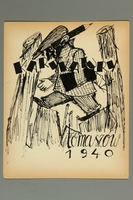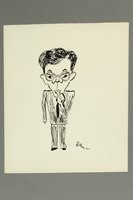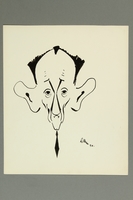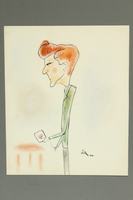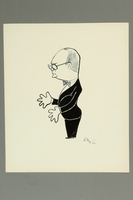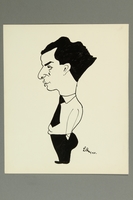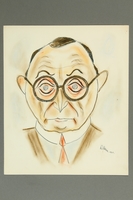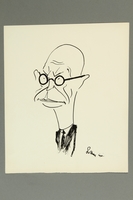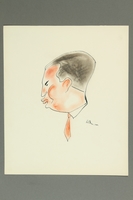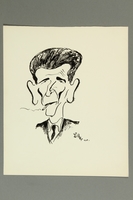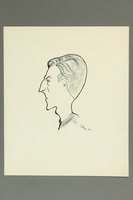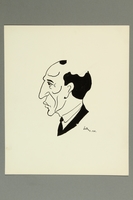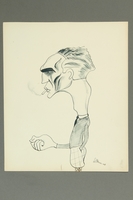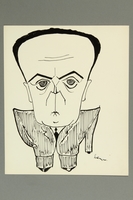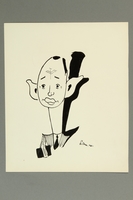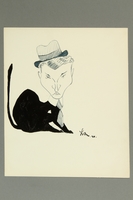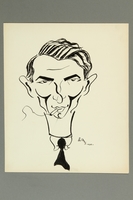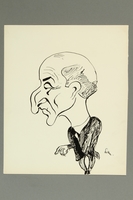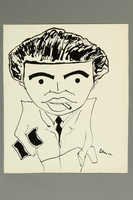Overview
- Description
- The Edith Brandon papers consist of biographical materials, correspondence, newspaper clippings, photographs, and a testimonial narrative documenting Edith Brandon’s deportation to Riga with her mother, Meta Blau; the lives of her boyfriend, Lutek Orenbach, in the Tomaszów-Mazowiecki ghetto and her friend, Ruth Goldbarth, in the Warsaw ghetto; and Edith’s Christian uncle, Hermann Bradtmüller, in Minden and the assistance he provided during the Nazi period.
Biographical materials include emigration, deportation, and identification records documenting Edith and her mother’s failed attempt to emigrate to Colombia, their deportation to Riga, Edith’s work status following liberation, her return to Minden, and her status as a concentration camp survivor.
Correspondence primarily consists of letters and postcards from Lutek Orenbach in the TomaszówMazowiecki ghetto and from Ruth Goldbarth in Warsaw and the Warsaw ghetto to Edith while she lived in Minden. Lutek’s correspondence describes conditions in the Tomaszów-Mazowiecki ghetto, his work for the Jewish Council, his participation in theatrical and musical performances in the ghetto, and his mental and emotional distress. Ruth’s correspondence reveals her sense of humor and critical eye while discussing mundane practical matters like the cost of various products and living conditions in the ghetto, her hopes and fears for the future, working for her father in his dental practice, and caring for her mother and sister as they grew ill. Ruth also used coded language to try to communicate about the actions of the Gestapo, German forces, and Polish and Russian threats. She gratefully acknowledges the packages of food and clothing Edith painstakingly gathered and sent, as well as Hermann Bradtmüller’s courageous visit to the Warsaw Ghetto. At the same time, she manages to smuggle letters out through Edith to relatives living overseas. Hans Bradtmüller saved Lutek’s and Ruth’s correspondence for Edith throughout the war. Correspondence from both Lutek and Ruth often includes notes at the end from other friends and family members. Additional correspondence from Edith and her mother to relatives documents their deportation and work on labor details.
Four photographs depict Edith Brandon, Lutek Orenbach, and forced laborers in Riga.
Three newspaper clippings document the establishment of the Warsaw ghetto and life inside the ghetto.
Edith Brandon’s narrative Ein Mindener Bürger describes her maternal aunt’s Christian husband, Hermann Bradtmüller, and his bravery in aiding Edith’s family and friends and fighting Nazi aggression and injustice. The collection includes an original 1945 version, a presentation booklet assembled in 1994, and an English translation - Date
-
inclusive:
1939-1994
bulk:
- Collection Creator
- Edith Brandon
Lutek Orenbach
Ruth Goldbarth - Biography
-
Edith Brandon was born September 24, 1921 to Heinrich and Meta Blau (née Samuel). She spent much of her childhood in the Free City of Danzig (now Gdansk, Poland), where her father ran an import/export business. Edith’s parents first met in her mother’s family home in Minden, a German garrison town where her father was stationed near the end of WWI. Edith and her mother made frequent visits to Minden during the interwar period, where they maintained close relationships with Meta Samuel’s family and friends. In 1938, after Edith’s father’s business in Gdansk was seized and the family’s attempts to emigrate failed, they moved to Bydgoszcz, Poland in hopes of recovering money owed to them there. It was in Bydgoszcz in the summer of 1939 that Edith befriended two remarkable young Jewish intellectuals: Lutek Orenbach and Ruth Goldbarth. The three developed close friendships during the summer of 1939, enlivened by their mutual love of literature and the arts and their incisive wit. Edith’s father was seized by the Germans in October 1939 and was never heard from again. Edith and Meta Blau fled to Minden and found refuge with Meta’s sister Frieda, her brother-in-law Hermann (Bubi) Bradtmüller, and their son Hans. In December 1941 Edith and her mother were transported to
Riga as forced laborers and worked unloading war materials at the docks nearby. In the autumn of 1944 they were transferred to the Stutthof concentration camp, where they worked on farm and trenchdigging details. They escaped during a blinding snowstorm as their labor detail returned to camp from Stoboje. They disguised their identities as foreign laborers and then as German ones to work for German troops. They were transported with those troops to Bornholm, Denmark, where they were finally liberated when the Red Army captured the city. They sought refuge with a local Danish family who sheltered them as they resumed their identities as German Jews. Only after intense interrogation by the Soviets were they recognized as victims of the Nazis and allowed to stay and work for the Red Army. They decided to return to Minden, where Edith met her future husband Edward (Ted) Brandon, who was stationed there with the British Royal Marines. Edith worked at arranging the stays of British volunteers with the Pioneer Corps Labor Unit, she and Ted married in June 1947, and they moved to London along with Edith’s mother.
Lutek Orenbach (Izrael Aljuche Orenbacha, 1919-1942), Edith Brandon’s boyfriend in the summer of 1939, had moved to Bydgoszcz from Łódź many years earlier. As German forces approached Bydgoszcz, the Orenbachs fled to Łódź and then joined relatives in Tomaszów-Mazowiecki. They were forced into the ghetto and are believed to have perished in Treblinka in 1942, though their exact fate is unknown.
Ruth Goldbarth, a friend of Edith Brandon’s in the summer of 1939, lived and attended school in Bydgoszcz, where her father had a well-established dental practice. Dr. Goldbarth was arrested by the Germans in October 1939 and released on condition he immediately relocate his family to Warsaw. Ruth is believed to have perished along with her entire family in the Warsaw ghetto sometime after April, 1942, though their exact fate is unknown.
Physical Details
- Genre/Form
- Photographs.
- Extent
-
1 box
- System of Arrangement
- The Edith Brandon papers are arranged as a five series: I. Biographical materials, 1939-1945, II. Correspondence, 1939-1944, III. Newspaper clippings, approximately 1940, IV. Photographs, approximately 1939-1945, V. Testimonial, 1945, 1994
Rights & Restrictions
- Conditions on Access
- There are no known restrictions on access to this material.
- Conditions on Use
- Material(s) in this collection may be protected by copyright and/or related rights. You do not require further permission from the Museum to use this material. The user is solely responsible for making a determination as to if and how the material may be used.
Keywords & Subjects
Administrative Notes
- Holder of Originals
-
United States Holocaust Memorial Museum
- Legal Status
- Permanent Collection
- Provenance
- Edith Brandon donated the Edith Brandon papers to the United States Holocaust Memorial Museum in 1996.
- Funding Note
- The cataloging of this collection has been supported by a grant from the Conference on Jewish Material Claims Against Germany.
- Record last modified:
- 2023-02-24 13:52:36
- This page:
- https://collections.ushmm.org/search/catalog/irn501254
Additional Resources
Download & Licensing
In-Person Research
- Available for Research
- Plan a Research Visit
-
Request in Shapell Center Reading Room
Bowie, MD

